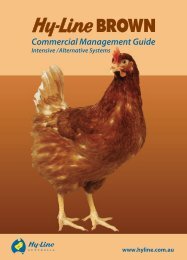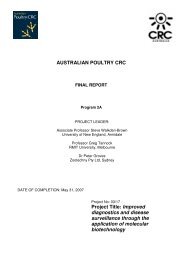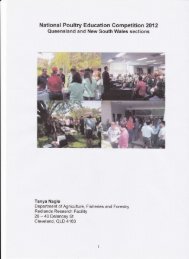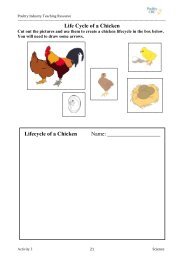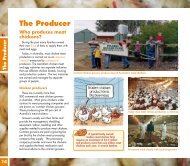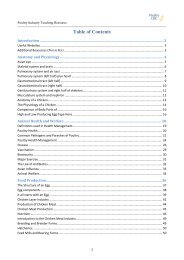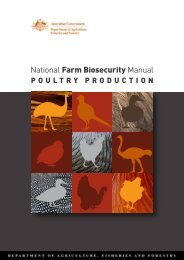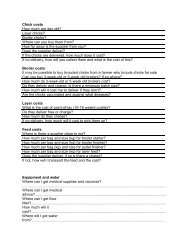2.2.7 Fermentation characteristics of lactobacilliFermentation characteristics of each group of Lactobacillus species were performed with the Ph-48generalized PhenePlate system (BactusAB, Huddinge, Sweden). This is based on intervalmeasurements of colour changes, visualized by the pH indicator (bromothymol blue), resulting frombacterial metabolism of two sets of 46 freeze-dried substrates including low–molecular-weightcarbohydrates (mono-, di-, and trisaccharides), carbohydrate derivatives (sugar alcohols, sugar acids,and glucosides), organic acids, urea, and ornithine.2.2.8 Enzyme-linked immunosorbent assay (ELISA)Total antibody titre concentrations of IgY, IgM, and IgA in serum were determined before Cpchallenge (14 d), and at 7 d after first challenge (21 d) using a sandwich ELISA. Blood samples werecollected from the jugular vein into 7-mL serum tubes and clotted at room temperature (RT) (25˚C) for2 h, and serum was separated from the cells by centrifugation (Beckman Instruments Inc., Palo Alto,CA, USA) at 2,300 x g for 5 min and stored at -20˚C. The specific IgY antibodies against the α-toxinof Cp in blood serum were determined as described by Heier et al. (2001), with some modifications2.2.9 Bird husbandryAll birds used under Strategy A were Cobb strain, obtained from a local hatchery (Baiada hatchery,Kootingal, NSW, Australia). They were vaccinated against Marek‟s disease, infectious bronchitis, andNewcastle disease prior to collection. At 1 d of age, chicks were randomly placed in brooder cages(42 cm x 75 cm x 25 cm dimension) with wire floor and with a floor space of 0.32 m 2 /cage. The cageswere randomly assigned to one of six dietary treatments with the appropriate number of replicates pertreatment. The temperature was set at 33-34˚C during the first week and gradually decreased by 3˚Cper week until 24-25˚C was reached by the third week. Relative humidity was between 65 and 70 %.A photoperiod of 24 h from 1 to 21 d of age, and 18 h from 22 to 42 d of age was maintained. Eachpen was equipped with a feeding and water trough placed outside and also an excreta collection tray.Water and feed were provided ad libitum. Weekly BWG and FI per cage were measured and FCR,adjusted for mortality, calculated on a cage basis. Birds were observed twice daily for general health.2.3 Strategy BThree experiments were conduct to address the second strategy of this project. Some of the methodswere common to those used for strategy A, and are described in section 2.6.0. Specific methods usedfor this strategy are described in the following sections.The first of the three experiments was conducted at the Agricultural University of Norway, Ås,approximately 20km south-east of Oslo. The feeding trial work was conducted inside a temperatureand light controlled environment on campus. The experiment commenced in May 2004 and wascompleted in June 2004.Feed was processed at The Agricultural University Center for Feed Technology Ltd. (FôrTek),situated on the University campus. All sample analyses were conducted on campus. Dry feed anddigesta particle size analysis was carried out using a Mastersizer 2000 LASER diffraction particle sizeanalyser, with Sirocco 2000 and Hydro 2000G accessories (Malvern Instruments Ltd., UK) used fordry and wet samples, respectively.8
2.3.1 TreatmentsA semi-purified diet consisting of 75 % sorghum and 12 % isolated soy protein was formulated. Priorto processing, the sorghum was sieved to remove excess debris and dust. Four treatments, differing inmean particle size and processing method used to modify the sorghum grain were compared.Treatments were based on sorghum processing type before pelleting and are described by method ofmilling, if any, and were as follows: Whole sorghum (WS); Hammer-mill – 3.0 mm screen (HM3);Roller-mill – 0.15 mm roller spacing (RM0.15), and Hammer-mill – 1.0 mm screen (HM1).Diet 3 (RM0.15) was ground to have a mean equivalent particle size of Diet 2 (HM3). Diets „WS‟ and„HM1‟ were used to represent extreme variations from the intermediate particle sizes used in dietsHM3 and RM0.15. The HM3 diet was used as a control, based on current processing methods used infeed milling. All dietary treatments were manufactured using the same formulation, which was semipurifiedto reduce the confounding effects of other factors, and excluded the use of antibiotics/growthpromotants and coccidiostats.2.3.2 Feed preparationAfter sieving, the sorghum needed for the experiment was divided into four portions corresponding tothe four treatments. After a 1mm screen was fitted to a commercially used 18.5kW hammermill(Münch-Edelstahl, Wuppertal, Germany, licensed by Bliss, USA), one portion of sorghum was fedthrough the machine to yield the sorghum used for diet treatment 4 (HM1). The same hammer-millwas then fitted with a 3 mm screen, and a second portion of sorghum was fed through the mill to yieldthe sorghum component for diet treatment 2 (HM3). A representative sample of the HM3 was takenand dry sieved using a Retsch AS 200 (F. Kurt Retsch GmbH & Co., Haan, Germany) and the meanparticle size calculated.Using trial and error, the two sets of a commercial 13kW roller-mill (Model DP 900-12, Roskamp,Indiana, USA) were adjusted to yield an equivalent mean sorghum particle size to the HM3 sorghum.The roller spacings were 0.15 mm at the top rollers and 0.15 mm at the bottom rollers. The resultingmilled sorghum was used in the third dietary treatment (RM0.15). The sorghum for the first treatmentwas left unprocessed prior to mixing. All dietary components, except for soy oil, were added to thesorghum and mixed thoroughly using a Dinnisen mixer (Pegasus Menger 400 1, Sevenum, Holland).All diets were steam-conditioned in a double conditioner (Münch-Edelstahl, Wuppertal, Germany) for60 seconds at an average conditioning temperature of 75˚C, and soy oil was added at this stage. Thediets were then steam-pelleted (Münch-Edelstahl, Wuppertal, Germany, RMP 350,100, 5000kg.h -1capacity) using a 3 mm die (42mm thick). The pellet press had two closed-end corrugated rolls set atapproximately 0.25 mm to the inner surface of the pellet die. For each diet, a pellet sample was takenimmediately as the pellets fell from the press and stored in a polystyrene box fitted with an electronicthermometer to measure post-pelleting temperature. All diets were cooled after pelleting in a MiltenzCounter Flow Cooler (Auckland, New Zealand, 2000kg.h -1 capacity). Average post-pelletingtemperatures, energy consumption and production rates of the pellet press of the four diets arepresented in Table 2.1.Table 2.1: Production characteristics of the four sorghum diets through a commercial steamconditioner and pellet press (Experiment one).Treatment WS HM3 RM0.15 HM1Pellet temperature ( o C) 83.9 82.3 81.8 84.0Power consumption (A) 83.9 82.3 81.8 84.0Production rate (kg/hr) 750-800 800 800 800Feeder rate (%) 40-45 45-50 45-50 45-509



